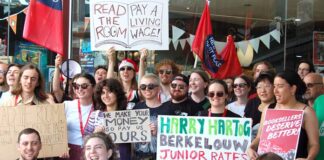Thousands of unionists took strike action against the Abbott government as part of the Australian Council of Trade Unions March 4 day of protest. Over 20,000 people joined the march in Melbourne, and over 5000 in Sydney.
The ACTU called the protests in response to the Abbott government’s new review of industrial relations. ACTU Secretary Dave Oliver told the Melbourne rally, “The Coalition government is using the Productivity Commission inquiry into rights at work in an attempt to cut penalty rates, abolish the minimum wage, bring back unfair individual contracts and swing even more power to the employers.”
Thousands of construction workers in Melbourne defied threats of fines from Fair Work Building and Construction, the current incarnation of the ABCC, to walk off the job. CFMEU secretary John Setka explained, “There have been threats of fines of $10,000 for turning up. That’s democracy Australian-style under the Liberal Party.” In Sydney unions shut down the massive construction site at Barangaroo, with 2500 workers from the site taking stop work action. Workers from other sites joined them as they marched through the city.
As many as 22 branches of the NSW Nurses and Midwives Association voted for industrial action, after the union left it up to individual branches to decide how they would support the rally. Over 650 nurses from across Sydney attended.
One nurse, Georgina, told Solidarity how her branch decided to take strike action to attend after, “I told the meeting that I remember the days when nursing had flat rates [before penalty rates]. We fought hard for something that this generation takes for granted. I argued that it would be very easy to lose something we fought long and hard for.” A third of some nurses’ wages consists of penalty rates.
Sydney’s rally targeted Liberal Premier Mike Baird, as part of a union electoral campaign following successful union mobilisation for Labor’s election in Queensland and Victoria.
Elsewhere the focus was on the next federal election, with the ACTU announcing it would hire 20 new full-time staff as part of a plan to target 32 marginal seats.
Yet the enthusiasm for taking strike action demonstrates the potential for successful, wider strikes against the Coalition’s cuts if the union leadership was prepared to lead the charge.
Such a campaign holds the power to stop the Coalition’s cuts before the next election, and put serious pressure on a future Labor government to deliver.
By Jean Parker






